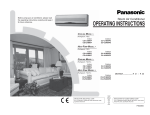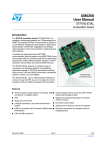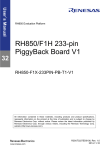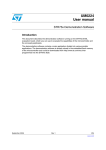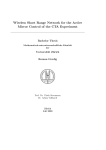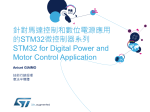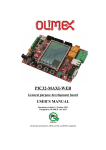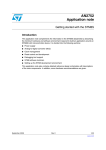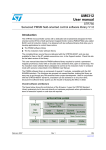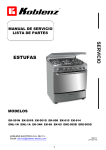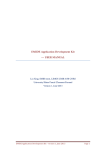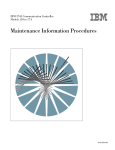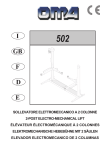Download STR750-STK User Manual
Transcript
STR750-STK development board Users Manual All boards produced by Olimex are ROHS compliant Revision A, December 2009 Copyright(c) 2010, OLIMEX Ltd, All rights reserved Page 1 INTRODUCTION STR750-STK is development board with high performance STR750F ARM7TDMI-STM microcontroller from STMicroelectronics. This microcontroller supports serial interfaces such as USB Device, UART, CAN and other. On the board are available JTAG, TFT LCD and SD/MMC card connector, UEXT, EXT, USB, CAN and two RS232 connectors. All this allows you to build a diversity of powerful applications to be used in a wide range of applications. BOARD FEATURES • MCU: STR750 • Standard JTAG connector with ARM 2x10 pin layout for programming/debugging with ARM-JTAG • USB 2.0 device port • 2x RS232 interface and drivers • 3x User Buttons • Trimmer potentiometer • NOKIA 6610 TFT COLOR LCD display 128x128 pixel 12 bit color with backlight • UEXT - 10 pin extension connector for Olimex addon peripherials like MP3, RF2.4Ghz, RFID etc. modules • On board voltage regulators with up to 800mA current • single power supply: 6-9VDC required • power supply LED • power supply filtering capacitor • RESET circuit • RESET button • 4 Mhz crystal • PCB: FR-4, 1.5 mm (0,062"), soldermask, silkscreen component print • Dimensions: 110.5 x 101.6 mm (4.35 x 3.99") Page 2 ELECTROSTATIC WARNING The STR750-STK board is shipped in protective anti-static packaging. The board must not be subject to high electrostatic potentials. General practice for working with static sensitive devices should be applied when working with this board. BOARD USE REQUIREMENTS Cables: The cable you will need depends on the programmer/debugger you use. If you use ARM-JTAG-EW, you will need USB A-B cable. Hardware: Programmer/Debugger ARM-JTAG-EW or other compatible programming/debugging tool if you work with EW-ARM. You can use also ARM-USB-OCD, ARM-USB-TINY, ARM-USB-OCD-H, ARMUSB-TINY-H, but we don't offer a project for this board with this programmers. PROCESSOR FEATURES STR750-STK board use STR750F ARM7TDMI-STM microcontroller with on-chip high-speed single voltage FLASH memory and high-speed RAM from STMicroelectronics with these features: − − − Core: − ARM7TDMI-S 32-bit RISC CPU − 56 DMIPS @ 60 MHz Memories − 256 Kbytes embedded Flash program memory (10k cycles endurance, data retention 20 yrs at 55°C) − 16 Kbytes Read While Write Flash for data storage (100k cycles endurance, data retention 20 yrs at 55°C) − Flash Data Readout Protection − 16 KBytes embedded SRAM − Memory mapped interface to ext. Serial Flash or EEPROM (64 MB) w.boot capability Clock, Reset and Supply Management − Single supply 3.3V ±10% or 5V ±10% − Embedded 1.8V Voltage Regulators with Low Power features − Smart Clock Controller with flexible clock generation capability: − Internal RC for fast start-up and backup clock mechanism. − Up to 60 MHz operation using internal PLL with 4 or 8 MHz crystal/ceramic osc. Page 3 − − − − − − Smart Low Power Modes: SLOW, WFI, STOP and STANDBY with backup registers. − Real Time Clock, driven by low power internal RC or 32.768 kHz dedicated osc, for clock-calendar and Auto Wake-up Nested interrupt controller − Fast interrupt handling with 32 vectors − 16 IRQ priorities, 2 maskable FIQ sources − 16 external interrupt / wake-up Lines DMA − 4-channel DMA controller − Circular buffer management − Support for UART, SSP, Timers, ADC 6 Timers − 16-bit watchdog timer (WDG) − 16-bit timer for system timebase functions − 3 Synchronizable timers each with 2 input captures and 2 output compare/PWMs. − 16-bit 6-channel synchronizable PWM timer − Dead time generation, edge/center-aligned waveforms and emergency stop 8 Communications Interfaces − 1 I2C interface − 3 HiSpeed UARTs w. Modem/LIN capability − 2 SSP serial interfaces (SPI or SSI) − 1 CAN interface (2.0B Active) − 1 USB 2.0, full-speed 12 MB/s interface with 8 configurable endpoint sizes. 10-bit A/D Converter − 16/11 channels with Fast Scan Mode − Programmable Analog Threshold Detection − Conversion time: min. 3µs − Conversion Range: 0 to VDD_IO − 72 GPIO lines with High Sink capabilities − Development Tools Support − JTAG interface (ARM Embedded ICE) Page 4 BLOCK DIAGRAM Page 5 MEMORY MAP Page 6 USB Page 7 1 2 3 4 CAN_RX CAN_TX 47uF/6.3VDC TXD VSS VDD RXD 470uF/16V C70 100nF C37 IN OUT AGND C36 0 100nF(NA) R43 R2 220/1%(NA) R4 100/1%(NA) ADJ/GND 47uF/6.3V SN65HVD230 RS CANH CANL VREF 3.3V + R5 120 8 7 6 5 U1 10K 2 R6 220uF/16V/mini CAN0 5 4 3 2 1 VR2(1.8V) LM1117(NA) C31 + R40 10K 9 8 7 6 3 C35 100nF R41 10K 1 + P2.01 R7 390/1% R20 240/1% C6 3.3V OUT 47uF/6.3V(NA) C5 1.8V R14 560 PWR 3.3V STR750F R32 GND 100nF C17 330 R13 B1 3.3V RST RESET 1 R37 10K 2 VCC U2 4.7K MCP130 3.3V 3 CNTRL/HS GND IN ADJ/GND 4MHz XT2 XT1 R60 0 B1 /RESET NA 100nF R38 10K 10 48 74 98 53 97 73 49 54 TXD0/BOOT1 330 R39 B2 3.3V C22 C29 VSS_IO1 VSS_IO2 VSS_IO3 VSS_IO4 VSS18 VSS18_1 VSSA_ADC VSSA_PLL VSSBKP V18BKP VDDA_PLL VDDA_ADC VREG_DIS B2 10K R58 R34 10K 3.3V 33nF C39 100n 3.3V AGND C9 C3 100n C11 100n 1 R35 10K 100nF C38 10nF C1 10uF/6.3V C43 FB2 330 R33 560 C33 100nF(NA) 1BOOT0 2 3 STAT 3.3V STAT WAKEUP 10K R57 3.3V 10uF/6.3V C8 FB1 3.3V EXT-1 EXT-2 EXT-3 EXT-4 1uF/6.3V C2 ferrite_bead/0805 VDDA 10nF C42 WAKEUP R61 2 ferrite_bead/0805 1 AGND 3.3V R46 4.7K 3.3V 1.8B_E 1.8V AGND AGND 1BOOT1 BOOT0 2 3 3.3V 2 1.8V_E EXT-35 EXT-34 EXT-33 EXT-32 EXT-31 EXT-30 EXT-36 VRE 1 100nF R3 1M VR1(3.3V) LM1117 C28 22p Q1 46 47 USB_DP USB_DN XRTC1 XRTC2 NRSTIN NRSTOUT TEST 55 45 70 75 96 52 44 69 99 2 5VAC 6VDC C30 15p(NA) C14 22p 66 65 57 56 59 58 9 V18 V18REG VDD_IO1 VDD_IO2 VDD_IO3 ADC_IN6 RXD2 TXD2 + C34 15p(NA) C73 USB_DUSB_D+ G ND /RESET CS_MMC STAT C10 27p Q2 C32 Q_GNDTC38H_SMD_GND 27p EXT-29 LCD_BL LCD_RESET CS_LCD P2.00 P2.01 P2.02 P2.03/UART1_RTS P2.04/TIM2_OC1 P2.05/PWM3N P2.06/PWM3 P2.07/PWM2N P2.08/PWM2 P2.09/PWM1N P2.10 P2.11 P2.12 P2.13 P2.14 P2.15 P2.16 P2.17/UART2_RTS P2.18 P2.19 R45 4.7K 3.3V + C72 R47 R48 R11 10K R-T 24 23 14 13 12 86 85 84 83 82 72 71 62 61 51 50 43 33 32 31 10uF/6.3V C40 G1 DB104(SMD) D2 1N5819S 22 22 TDO TRST TDI TMS TCK P2.01 EXT-37 EXT-40 EXT-39 EXT-38 7 3 8 4 Q D C #S 2 5 6 1 AGND M25P64-VME(NA) #HOLD #W/VPP VCC VSS U3 C41 100n GND15 R1IN R2IN http://www.olimex.com/dev COPYRIGHT(C), 2009 Rev. A 3 MISO0 MOSI0 SCLK0 SPI0_NSS AN_TR 10K VDDA V- V+ T1OUT T2OUT U5PWR 16VCC R1OUT R2OUT T1IN T2IN C2- C2+ C1- C1+ U5 ST3232 C7 470p + STR750-STK 3.3V 330 R56 100nF C4 AGND ADC_IN6 3.3V 12 9 RXD2 RXD1 5 4 3 1 11 10 C26 100n C27 100n LCD_BL R28 1K C15 10u/6.3V FET1 IRLML6402 TXD2 TXD1 R27 1M 3.3V L1 220u FB SC SE 6 1 1 2 3 4 5 R59 10K NC NC R24 6 7 8 9 BL_PWR 6 7 8 9 LEDGND GND VLED RESET SCK DIO CS R25 NC R23 NC UEXT-1 UEXT-2 UEXT-3 UEXT-4 UEXT-5 UEXT-6 UEXT-7 UEXT-8 UEXT-9 UEXT-10 VDISPLAY VDIGITAL TXD0/BOOT1 RXD0 SCL SDA MISO1 MOSI1 SCLK1 SPI1_NSS 3.3V 9 8 10 BL_PWR 2 R26 10K 1 2 3 4 5 R22 R31 1.2k/1% RS232_1 LCD_RESET 3.3V 3.3V R30 5.6k/1% RS232_2 4 3 5 3.3V D1 1N5819S SCLK1 MOSI1 CS_LCD C13 100n C25 100n 5 1 2 150 R29 MC34063 R36 100K 13 8 14 7 6 2 TC U6 1 R1 4 USB +5V_USB R55 150 EXT-17 EXT-18 EXT-19 EXT-20 EXT-21 EXT-22 EXT-23 EXT-24 EXT-25 EXT-26 EXT-27 EXT-28 EXT-16 RTCK CAN_RX CAN_TX SCLK1 MISO1 MOSI1 SPI1_NSS RXD1 TXD1 SPI0_NSS SCLK0 MISO0 MOSI0 SCL SDA RXD0 TXD0/BOOT1 BOOT0 + 100n R49 1.5K 3.3V R50 10K R10 NA 4 3 2 100 79 78 77 76 30 29 28 27 26 25 64 63 42 41 40 39 17 16 15 11 38 37 36 35 8 7 6 5 + C74 R42 10K /RESET RTCK R9 10K 2 1 R12 10K 1 3 5 7 9 11 13 15 17 19 R18 R8 10K 10K SD/MMC-bot CP1 CP2 P0.00/TIM0_OC/BOOT0 P0.01/TIM0_TI1/MCO P0.02/TIM2_OC1/ADC_IN0/EIT0 P0.03/TIM2_TI1/ADC_IN1 P0.04/SMI_CS0/SPI0_NSS P0.05/SPI0_SCLK/SMI_CK/EIT1 P0.06/SMI_DIN/SPI0_MISO P0.07/SMI_DOUT/SPI0_MOSI/EIT2 P0.08/I2C_SCL/EIT3 P0.09/I2C_SDA P0.10/UART0_RX/SMI_CS3/EIT4 P0.11/UART0_TX/BOOT1/SMI_CS2 P0.12/UART0_CTS/ADC_IN2/SMI_CS1 P0.13/RTCK/UART0_RTS P0.14/CAN_RX/EIT5 P0.15/CAN_TX P0.16/SPI1_SCLK P0.17/SPI1_MISO/ADC_IN3 P0.18/SPI1_MOSI P0.19/USB_CK/SPI1_NSS/ADC_IN4/EIT6 P0.20/UART1_RX P0.21/UART1_TX P0.22/UART1_CTS/ADC_IN5 P0.23/UART1_RTS/ADC_IN6 P0.24/UART2_RX P0.25/UART2_TX P0.26/UART2_CTS P0.27/UART2_RTS/ADC_IN7 P0.28/TIM1_OC1 P0.29/TIM1_TI1/ADC_IN8 P0.30/TIM1_OC2 P0.31/TIM1_TI2 VDDA 1 2 3 4 2 4 6 8 10 12 14 16 18 20 JTAG 2K 13 15 U4 P1.00/TIM0_OC2 P1.01/TIM0_TI2 P1.02/TIM2_OC2 P1.03/TIM2_TI2 P1.04/PWM3N/ADC_IN9 P1.05/PWM3/EIT7 P1.06/PWM2N/ADC_IN10 P1.07/PWM2/EIT8 P1.08/PWM1N/ADC_IN11 P1.09/PWM1/EIT9 P1.10/PWM_EMERGENCY/EIT10 P1.11/ADC_IN12/EIT11 P1.12/ADC_IN13/EIT12 P1.13/ADC_IN14/EIT13 P1.14 P1.15/WKP_STDBY/EIT15 P1.16/JTDI P1.17/JTDO P1.18/JTCK P1.19/JTMS NJTSRST 220uF/16V C16 + PWR_JACK 3.3V R15 CP B1 B2 CP WP WAKEUP TDI TDO TCK TMS TRST 95 94 68 67 91 90 89 88 87 81 80 34 1 93 92 60 21 20 19 18 22 VSS 33K R21 CD/DAT3/CS CMD/DI VSS1 VDD CLK/SCLK VSS2 DAT0/DO DAT1/RES DAT2/RES WP1 WP2 EXT-5 EXT-6 EXT-7 EXT-8 EXT-9 EXT-10 EXT-11 EXT-12 EXT-13 EXT-14 EXT-15 VCC 3.3V R52 10 14 SD/MMC 6 3.3V 3.3V 3.3V MOSI0 WP 1 2 3 4 3.3V SCLK0 5 10k 6 MISO0 7 10K 8 R53 10K 9 R54 0 100K 2k 33k DC IS MISO0 R17 R19 R16 R51 8 7 SCLK0 CS_MMC MOSI0 3.3V 3.3V SCHEMATIC + CAN0_T 1 2 BOARD LAYOUT Page 8 POWER SUPPLY CIRCUIT STR750-STK can take power (+6 V) from PWR_JACK, and (+5 V) from USB. The programmed board power consumption is about 140 mA with all peripherials enabled. RESET CIRCUIT STR750-STK reset circuit includes jumper R-T, pin 15 of JTAG connector, STR750F pin 59 (NRSTIN), U2 (MCP130) and RESET button. CLOCK CIRCUIT Quartz crystal 4 MHz is connected to STR750F pin 46 (XT2) and pin 47 (XT1). Quartz crystal 32.768 kHz is connected to STR750F pin 56 (XRTC2) and pin 57 (XRTC1). JUMPER DESCRIPTION CAN0_T This jumper assures correct work of the CAN. At each end of the bus it should be closed. This means that if you have only two devices with CAN, the jumpers of both devices should be closed. If you have more than two devices, only the two enddevices should be closed. Default state is closed. 1.8V_E Default state is closed. 1.8B_E Default state is open. VRE Default state is closed. CNTRL/HS Default state is in position CNTRL. R-T Default state is closed. BOOT0 Default state is 0. BOOT1 Default state is 0. Page 9 INPUT/OUTPUT Status led (red) with name STAT connected to STR750F pin 31 (P2.19). Power-on LED (red) with name PWR – this LED shows that +3.3V is applied to the board. User button with name B1 connected to STR750F pin 34 (P1.11). User button with name B2 connected to STR750F pin 1 (P1.12). User button with name WAKEUP connected to STR750F pin 60 (P1.15/WKP_STDBY). User button with name RESET connected to STR750F pin 59 (NRSTIN). Trimpot with name AN_TR connected to STR750F pin 11 (P0.23/ADC_IN6). TFT LCD - 128x128 12 bit color with backlight. Page 10 EXTERNAL CONNECTORS DESCRIPTION RS232_1 Pin # Signal Name 1 NC 2 T2OUT 3 R2IN 4 NC 5 GND 6 NC 7 NC 8 NC 9 NC RS232_2 Pin # Signal Name 1 NC 2 T1OUT 3 R1IN 4 NC 5 GND 6 NC 7 NC 8 NC 9 NC Page 11 PWR_JACK Pin # Signal Name 1 Power Input 2 GND UEXT Pin # Signal Name 1 3.3V 2 GND 3 TXD0/BOOT1 4 RXD0 5 SCL 6 SDA 7 MISO1 8 MOSI1 9 SCLK1 10 SPI1_NSS USB Pin # Signal Name 1 +5V_USB 2 USB_D- 3 USB_D+ 4 GND Page 12 JTAG The JTAG connector allows the software debugger to talk via a JTAG (Joint Test Action Group) port directly to the core. Instructions may be inserted and executed by the core thus allowing STR750 memory to be programmed with code and executed step by step by the host software. For more details refer to IEEE Standard 1149.1 - 1990 Standard Test Access Port and Boundary Scan Architecture and STR750 datasheets and users manual. Pin # Signal Name Pin # Signal Name 1 3.3V 2 3.3V 3 TRST 4 GND 5 TDI 6 GND 7 TMS 8 GND 9 TCK 10 GND 11 RTCK 12 GND 13 TDO 14 GND 15 /RESET 16 GND 17 pull-down 18 GND 19 +5V_J-LINK 20 GND Page 13 EXT Pin # Signal Name Pin # Signal Name 1 3.3V 2 GND 3 AVDD 4 AGND 5 P1.00 6 P1.01 7 P1.02 8 P1.03 9 P1.04 10 P1.05 11 P1.06 12 P1.07 13 P1.08 14 P1.09 15 P1.10 16 P2.00 17 P2.02 18 P2.03 19 P2.04 20 P2.05 21 P2.06 22 P2.07 23 P2.08 24 P2.09 25 P2.10 26 P2.11 27 P2.12 28 P2.13 29 P2.17 30 P0.31 31 P0.30 32 P0.29 33 P0.28 34 P0.27 35 P0.26 36 P0.22 37 P0.12 38 P0.03 39 P0.02 40 P0.01 Page 14 SD/MMC Pin # Signal Name Pin # Signal Name 1 CS_MMC 2 MOSI0 3 GND 4 VDD 5 SCLK0 6 GND 7 MISO0 8 pull-up 9 pull-up 10 WP 11 - 12 - 13 CP 14 pull-down 15 pull-down CAN0 Pin # Signal Name 1 NC 2 JMP CAN0_T; CANL 3 GND 4 NC 5 NC 6 GND 7 CANH 8 pull-down 9 pull-up Page 15 MECHANICAL DIMENSIONS Page 16 AVAILABLE DEMO SOFTWARE – Jim Lynch's NOKIA 6610 LCD tutorial – OpenOCD + Eclipse set of projects 1.00 include flash write make file for STR-750STK. Page 17 ORDER CODE STR750-STK - assembled and tested board, includes STR750 microcontroller How to order? You can order to us directly or by any of our distributors. Check our web www.olimex.com/dev for more info. Revision history Revision A, December 2009 Page 18 Disclaimer © 2010 Olimex Ltd. All rights reserved. Olimex®, logo and combinations thereof, are registered trademarks of Olimex Ltd. Other terms and product names may be trademarks of others. The information in this document is provided in connection with Olimex products. No license, express or implied or otherwise, to any intellectual property right is granted by this document or in connection with the sale of Olimex products. Neither the whole nor any part of the information contained in or the product described in this document may be adapted or reproduced in any material from except with the prior written permission of the copyright holder. The product described in this document is subject to continuous development and improvements. All particulars of the product and its use contained in this document are given by OLIMEX in good faith. However all warranties implied or expressed including but not limited to implied warranties of merchantability or fitness for purpose are excluded. This document is intended only to assist the reader in the use of the product. OLIMEX Ltd. shall not be liable for any loss or damage arising from the use of any information in this document or any error or omission in such information or any incorrect use of the product. Page 19



















